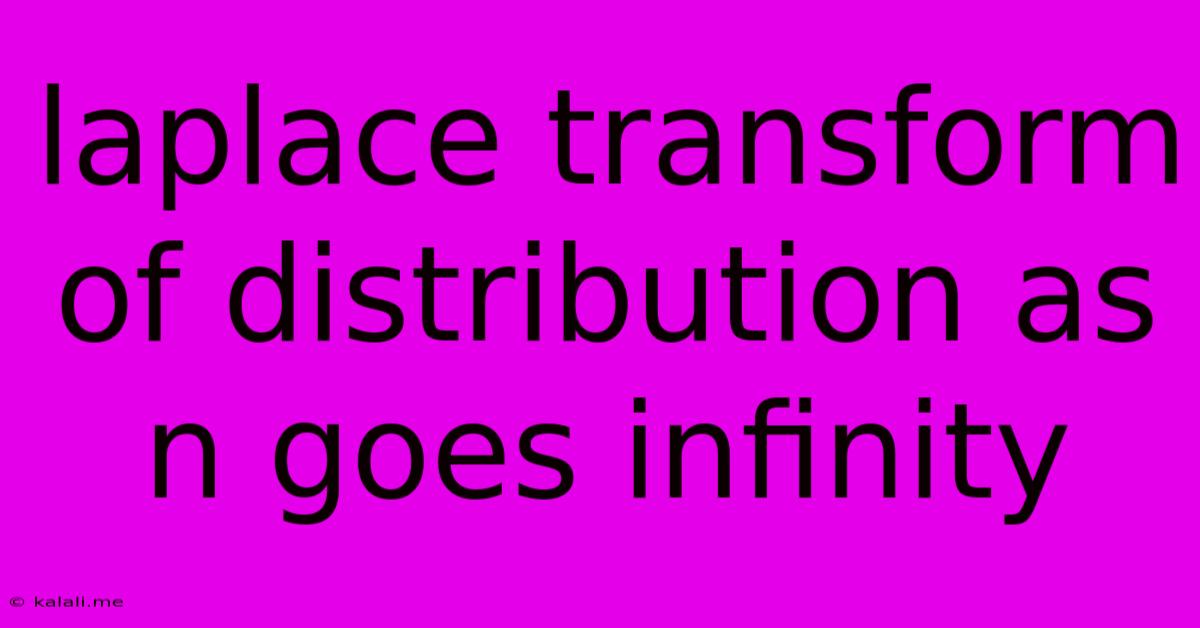Laplace Transform Of Distribution As N Goes Infinity
Kalali
May 24, 2025 · 3 min read

Table of Contents
The Laplace Transform of Distributions: Exploring the Limit as n Approaches Infinity
This article delves into the fascinating topic of the Laplace transform applied to distributions, specifically examining the behavior of the transform as the parameter n tends towards infinity. We'll explore the theoretical underpinnings and provide illustrative examples to clarify the concepts involved. Understanding this limit is crucial in various applications, including signal processing, probability theory, and the study of asymptotic behavior in dynamical systems.
The Laplace transform, a powerful tool in mathematical analysis, extends naturally to the realm of distributions (generalized functions). While the classical Laplace transform operates on functions, its generalized version handles objects like the Dirac delta function, which are not functions in the traditional sense. This extension allows us to analyze systems with impulsive behavior and singular inputs, offering a broader framework for problem-solving.
Understanding the Laplace Transform of Distributions
The Laplace transform of a distribution f(t) is defined as:
ℒ{f(t)}(s) = <f(t), e<sup>-st</sup>>
where < , > denotes the duality pairing between the distribution and a test function. The test functions are usually infinitely differentiable functions with compact support. This definition elegantly bypasses the need for a traditional integral, which might not be defined for all distributions. Instead, it relies on the action of the distribution on a specific test function, e<sup>-st</sup>.
Examining the Limit as n → ∞
The key focus here is analyzing the behavior of the Laplace transform as a parameter n within the distribution or its argument approaches infinity. This often involves sequences of distributions {f<sub>n</sub>(t)} such that:
lim<sub>n→∞</sub> f<sub>n</sub>(t) = f(t)
where the convergence is in the sense of distributions. We are interested in understanding if:
lim<sub>n→∞</sub> ℒ{f<sub>n</sub>(t)}(s) = ℒ{f(t)}(s)
This convergence is not always guaranteed. The limit might not exist, or it might converge to a different distribution's Laplace transform. This depends heavily on the specific nature of the sequence {f<sub>n</sub>(t)} and the properties of the Laplace transform.
Illustrative Examples
Let's consider a few examples to illustrate different scenarios:
Example 1: Approximating the Dirac Delta Function:
We can approximate the Dirac delta function using a sequence of Gaussian functions:
f<sub>n</sub>(t) = (n/π)<sup>1/2</sup> * e<sup>-n*t²</sup>
As n approaches infinity, f<sub>n</sub>(t) converges to δ(t) in the distributional sense. The Laplace transform of f<sub>n</sub>(t) is:
ℒ{f<sub>n</sub>(t)}(s) = e<sup>-s²/4n</sup>
As n → ∞, ℒ{f<sub>n</sub>(t)}(s) → 1, which is the Laplace transform of δ(t). This demonstrates a case where the limit of the Laplace transforms converges to the Laplace transform of the limit distribution.
Example 2: A More Complex Scenario:
Consider a sequence of distributions involving the Heaviside step function, u(t). More complex sequences might involve oscillatory behavior or other properties that impact the convergence of the Laplace transform as n goes to infinity. A thorough analysis would require careful examination of the specific sequence and its convergence properties in the distributional sense. Analyzing such cases often requires advanced techniques from functional analysis.
Conclusion
Determining the limit of the Laplace transform of distributions as n approaches infinity is a nuanced problem requiring a deep understanding of distribution theory and the properties of the Laplace transform. The behavior depends critically on the specific sequence of distributions and their convergence. While simple examples, such as the approximation of the Dirac delta function, demonstrate consistent convergence, more complex scenarios necessitate a careful and case-by-case analysis. This study provides valuable insights into the asymptotic behavior of systems modeled using distributions and their Laplace transforms, enhancing our understanding across various scientific and engineering disciplines.
Latest Posts
Latest Posts
-
How Many Ounces Is A Cup Of Cheese
May 24, 2025
-
How To Fix A Door That Wont Latch
May 24, 2025
-
Are All The Overlord Movies Recaps
May 24, 2025
-
How Do I Get Gasoline Smell Off My Hands
May 24, 2025
-
How To Find A Survey Of My Property Online
May 24, 2025
Related Post
Thank you for visiting our website which covers about Laplace Transform Of Distribution As N Goes Infinity . We hope the information provided has been useful to you. Feel free to contact us if you have any questions or need further assistance. See you next time and don't miss to bookmark.